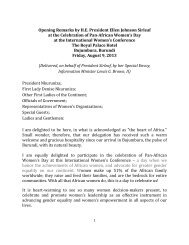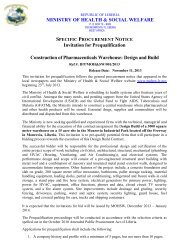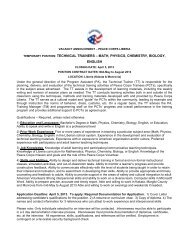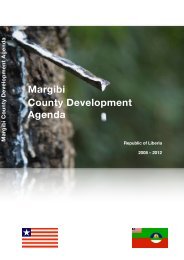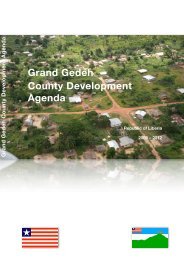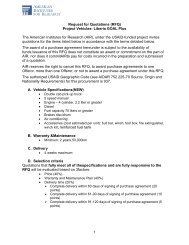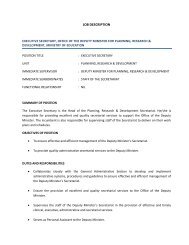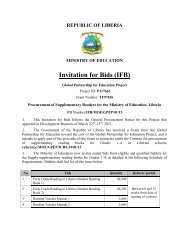National Housing Authority Program for the Construction of 5000
National Housing Authority Program for the Construction of 5000
National Housing Authority Program for the Construction of 5000
- No tags were found...
You also want an ePaper? Increase the reach of your titles
YUMPU automatically turns print PDFs into web optimized ePapers that Google loves.
AcknowledgementsThe <strong>National</strong> <strong>Housing</strong> <strong>Authority</strong> extends its thanks and appreciation to <strong>the</strong> President <strong>of</strong> Liberia,Her Excellency Mrs. Ellen Johnson Sirleaf <strong>for</strong> her vision in directly establishing this deliverableas part <strong>of</strong> her 150-Day Action Plan.We are also grateful to all those who have helped to make this <strong>Program</strong> document a reality. Weare particularly grateful to <strong>the</strong> members <strong>of</strong> <strong>the</strong> <strong>Housing</strong> Sector Working Group that was <strong>for</strong>medto develop <strong>the</strong> <strong>Program</strong> <strong>for</strong> <strong>the</strong>ir time and valuable contributions to <strong>the</strong> ef<strong>for</strong>t. The WorkingGroup Members are as follows:Central Bank <strong>of</strong> LiberiaMinistry <strong>of</strong> Internal AffairsMinistry <strong>of</strong> Planning & Economic AffairsMinistry <strong>of</strong> Public WorksWe also acknowledge <strong>the</strong> invaluable suggestions received from <strong>the</strong> UN Habitat during <strong>the</strong>development <strong>of</strong> <strong>the</strong> document plus photographs from Ecohomes Liberia Inc.i
A HOUSING DEVELOPMENT AND HOME OWNERSHIP PROPOSALFOR LIBERIASatellite photograph <strong>of</strong> Steven A. Tolbert <strong>Housing</strong> Estate, built in 1979I. OVERVIEW<strong>Housing</strong> is a social good, an asset which promotes individual and collective dignity, privacy andsecurity. In <strong>the</strong> economic sphere, housing contributes to employment creation and, laborproductivity, community economic development and capital <strong>for</strong>mation at both <strong>the</strong> micro andmacroeconomic levels. <strong>Housing</strong> also has impact on environmental management.<strong>Housing</strong> is an important component <strong>of</strong> <strong>the</strong> economic and social development <strong>of</strong> Liberia and <strong>the</strong>world at large. It is an important part <strong>of</strong> national infrastructure development and is pivotal tosocial development, national competitiveness and economic growth. Availability <strong>of</strong> af<strong>for</strong>dablehousing remains one <strong>of</strong> Liberia’s most pressing social/development problems. While somemiddle income and most upper-income housing are comparable to that in neighboring countries<strong>of</strong> West Africa, facilities <strong>for</strong> low-income groups are substandard. However, across all incomecategories, <strong>the</strong> development <strong>of</strong> housing in Liberia has generally been unplanned with very littleattention paid to zoning and <strong>the</strong> provision <strong>of</strong> communal sites and services such as electricity,water and sewage treatment/disposal. The problem has been aggravated by constant migrationfrom <strong>the</strong> rural areas to <strong>the</strong> cities due to <strong>the</strong> civil crisis and <strong>the</strong> search <strong>for</strong> better economicconditions, causing a rapid growth <strong>of</strong> urban slums. Much <strong>of</strong> <strong>the</strong> demand <strong>for</strong> housing is related topopulation growth and accumulated unmet needs.According to <strong>the</strong> LISGIS <strong>National</strong> Population & <strong>Housing</strong> Census 2008 Report, <strong>the</strong> totalpopulation <strong>of</strong> Liberia in March, 2008 was reported as 3,476,608 persons (see Appendix I). Theprojected growth in population is expected to double <strong>the</strong> 2008 figure by 2041 if <strong>the</strong> averageannual growth rate <strong>of</strong> 2.1 percent persists into <strong>the</strong> future. It can be said that this is a relativelyshort period <strong>of</strong> time within which <strong>the</strong> provision <strong>of</strong> all public goods and facilities should alsodouble, if only to maintain <strong>the</strong> current standard <strong>of</strong> living and provision <strong>of</strong> services to <strong>the</strong>population. Fur<strong>the</strong>rmore, if every Liberian household <strong>of</strong> average 5.5 persons were to have aseparate unit <strong>of</strong> housing out <strong>of</strong> a population <strong>of</strong> 3,476,608 persons, Liberia will need a total <strong>of</strong>1
Workmen laying laterite & sandcrete bricks at Ecohomes Schiefflin Town Projectsuch as architects, civil engineers, masonry, carpenters, plumbers, electricians, etc. Generally,housing constitutes a major component <strong>of</strong> household wealth, especially <strong>for</strong> low-incomehouseholds, and no doubt, housing wealth is increasingly gaining importance in <strong>the</strong> Liberianeconomy. For many households, it is <strong>the</strong> most important <strong>for</strong>m <strong>of</strong> savings as homeownership isconsidered as a hedge against inflation in <strong>the</strong> medium term. In o<strong>the</strong>r instances, it is utilized ascollateral <strong>for</strong> borrowing by homeowners, <strong>the</strong>reby generating funds <strong>for</strong> o<strong>the</strong>r investmentopportunities and wealth creation.The very powerful role <strong>the</strong> housing sector can play in economic growth, recovery and sociopoliticalstability is what has underpinned ef<strong>for</strong>ts by <strong>the</strong> USA, Sweden and o<strong>the</strong>r developedcountries to place a very special and sustained policy focus on <strong>the</strong> housing sector throughsupport <strong>for</strong> construction and mortgage lending as discussed below. In Africa, <strong>the</strong> South Africanshave also clearly understood this linkage as indicated by Vuyisani Moss in his analysis <strong>of</strong>varying policy approaches adopted by <strong>the</strong> four African countries included in his study 1 .Whereas, Ghana had a very low ratio <strong>of</strong> Mortgage Debt Outstanding to GDP <strong>of</strong> only 3.9% in2006 versus <strong>the</strong> normal 7-15% range <strong>for</strong> most Middle Income countries, South Africa is high upat close to 40%, next to <strong>the</strong> USA and Sweden per <strong>the</strong> below table 2 :1 Vuyisani Moss, Preview <strong>of</strong> <strong>Housing</strong> Finance Systems in Four Different African Countries: South Africa, Nigeria, Ghana andTanzania, 2003, p. 92 Monica Hjeds Löfmark, Growth, <strong>Housing</strong> Finance & Land Administration Chain, <strong>National</strong> <strong>Housing</strong> Credit Guarantee Board(BKN), Sweden, 2010, p.53
The above analysis makes a very strong case <strong>for</strong> affirmative action by GoL aimed at improving<strong>the</strong> lifestyles <strong>of</strong> <strong>the</strong> Liberian people by injecting long term liquidity into <strong>the</strong> banking system, andtaking additional targeted affirmative action such as sharing <strong>of</strong> lending risks with <strong>the</strong> bankingsystem through credit guarantees and providing subsidies to low income housing via directbudget support <strong>for</strong> sites and services in order to remove impediments to effective demand <strong>for</strong>housing, and stimulate growth and employment through this vital economic sector.A house does not only provide shelter but also serves as a measure <strong>of</strong> social standing andprestige. The lack <strong>of</strong> long term finance to enable low and medium income earners own <strong>the</strong>irhomes is one <strong>of</strong> <strong>the</strong> major issues that limit housing construction and delivery. This has a directimpact on <strong>the</strong> socio-economic development <strong>of</strong> <strong>the</strong> country. Accordingly, <strong>the</strong> rationale <strong>for</strong> thispolicy document is to chart a new path towards improving <strong>the</strong> socio-economic standards <strong>of</strong> ourcitizens and residents and <strong>the</strong> infrastructure <strong>of</strong> our country through a robust and dynamic housingdevelopment policy that will promote massive home construction, stimulate economic growthand create jobs throughout Liberia.III.AIMS AND OBJECTIVESThis <strong>Program</strong> aims to ensure <strong>the</strong> achievement <strong>of</strong> economic justice by making a large quantum <strong>of</strong>af<strong>for</strong>dable housing available to Liberians in <strong>the</strong> low-to-middle income brackets <strong>for</strong> homeownership within <strong>the</strong> next 3-6 years. It proposes to start a new trend <strong>of</strong> well zoned and betterplanned housing developments across Liberia, to counteract <strong>the</strong> current pattern <strong>of</strong> rapidunplanned urban sprawl and slum creation due to a prior lack <strong>of</strong> a policy focus and poor interagencycoordination.The <strong>Program</strong> will strongly support <strong>the</strong> new Decentralization Policy <strong>of</strong> <strong>the</strong> Government <strong>of</strong> Liberiawhereby modern administrative hubs will be built to facilitate taking various public servicescloser to <strong>the</strong> people in <strong>the</strong> counties, by providing homes and ancillary facilities such as shopping,leisure and recreation, schools, police stations, etc., <strong>for</strong> civil servants who will work in <strong>the</strong> hubs,public schools, health centers, police, immigration, courts, local government and o<strong>the</strong>r facilities.Civil servants plus o<strong>the</strong>r Liberians and residents would be able over time to relocate to wellplanned communities nationwide. This will contribute to reversing <strong>the</strong> trend <strong>of</strong> rural-to-urbanmigration by creating viable alternative living environments outside <strong>of</strong> Monrovia.The implementation approach would be via Public-Private Partnership whereby GoL facilitatesaccess to title-free land through <strong>the</strong> NHA, contributes to <strong>the</strong> cost <strong>of</strong> sites and servicesinfrastructure that is planned with <strong>the</strong> technical support <strong>of</strong> <strong>the</strong> Ministry <strong>of</strong> Public Works (MPW),Liberia Electricity Corporation (LEC) and Liberia Water & Sewer Corporation (LWSC), andgrants investment incentives such as import duty exemptions to encourage experienced privatehousing investors/developers to provide complementary funding and construct <strong>the</strong> housingestates. The NHA would foster collaboration among <strong>the</strong> various parties mentioned above. GoLfunding through an integrated project budget in <strong>the</strong> Medium Term Expenditure Frameworkwould be placed under <strong>the</strong> NHA which would coordinate disbursements to relevant sectoragencies in collaboration with <strong>the</strong> MoF. This plus Corporate Social Responsibility fundingwould subsidize <strong>the</strong> low cost housing component <strong>of</strong> <strong>the</strong> projects by covering <strong>the</strong> significant sitesand services cost element which would not be passed on to <strong>the</strong> low income houses in <strong>the</strong> estates.4
network extends to <strong>the</strong>m. This will lead to an increase in <strong>the</strong> number <strong>of</strong> civil servants seekinghomes to man <strong>the</strong> hubs in <strong>the</strong>se counties, along with o<strong>the</strong>r value chain players.Increased economic and administrative activity will mean a stronger base <strong>of</strong> gainfully employedpersons who can enter into home mortgage programs and rental/lease-purchase <strong>of</strong> a significantlyincreased stock <strong>of</strong> apartments. The provision <strong>of</strong> viable urbanized environments in areas outside<strong>of</strong> central Monrovia will also be more attractive to Liberians in Diaspora as a target <strong>for</strong> homeacquisition. Given <strong>the</strong> high and increasing level <strong>of</strong> Workers’ Remittances from US$260.0Million as <strong>of</strong> November 2010 to US$ 435.4 Million as <strong>of</strong> November 2011 12 , this could become akey source <strong>of</strong> funding to purchase <strong>the</strong> homes to be constructed under this program.B. Replication and ExpansionThe implementation approach <strong>of</strong> a Public Private Partnership that has been discussed above canbe replicated throughout <strong>the</strong> country. GoL seed capital <strong>for</strong> <strong>the</strong> zoning, layout and development <strong>of</strong>sites and services in <strong>the</strong> cities can be provided ei<strong>the</strong>r through direct MTEF budget programmingor from County Development Funding allocations. Additional subsidies could be providedthrough Corporate Social Responsibility programs <strong>of</strong> GoL Agencies such as NOCAL andNasscorp and/or entities like Mittal, Firestone, Chevron, China Union, Sime Darby, Putu IronOre and Golden Veroleum <strong>for</strong> <strong>the</strong>ir employees. We recommend that GoL engages <strong>the</strong>seentities to seriously consider this option versus higher outlays to build worker housing in <strong>the</strong>various concession areas. S<strong>of</strong>t loan funding will also be sought over <strong>the</strong> current MTEF periodto supplement <strong>the</strong> above funding <strong>for</strong> sites and services in consultation with <strong>the</strong> DebtManagement Committee <strong>of</strong> <strong>the</strong> Ministry <strong>of</strong> Finance.To overcome capacity constraints, construction work would be implemented by privatecontractors and/or experienced housing developers (e.g., CICO - China, Enable Properties/NovoDomus – S. Africa, Green Solar Companies - USA) under supervision <strong>of</strong> Project ManagementCommittees involving <strong>the</strong> GoL infrastructure agencies (i.e., MPW, LEC and LWSC), NHA,Ministry <strong>of</strong> Internal Affairs (MIA) representatives and private entities mentioned above. Thisapproach is very replicable and can be expanded across <strong>the</strong> country.C. Sequencing <strong>of</strong> <strong>Housing</strong> Development <strong>Program</strong>We believe that as a minimum condition two main criteria should determine <strong>the</strong> timing and <strong>the</strong>focus <strong>of</strong> <strong>the</strong> <strong>Housing</strong> Development <strong>Program</strong>. They are: a) population density <strong>of</strong> <strong>the</strong> county andb) location on <strong>the</strong> Vision 2030 growth corridor. However, as <strong>the</strong> GoL’s resource positionimproves and as <strong>the</strong> country’s capacity to simultaneously implement several housingconstruction projects through <strong>the</strong> PPP model is proven, <strong>the</strong> pace <strong>of</strong> <strong>the</strong> <strong>Program</strong> could beaccelerated. We should note, however, that in Montserrado, Margibi and Bomi Counties, basedon recent expressions <strong>of</strong> interest and ongoing discussions between <strong>the</strong> NHA and private housingdevelopers, <strong>the</strong> overall numbers could exceed 5,000 homes throughout <strong>the</strong> country over <strong>the</strong> next5-6 years if adequate funding can be sourced to make <strong>the</strong> contemplated investments. Below is<strong>the</strong> tentative sequencing <strong>of</strong> <strong>the</strong> <strong>Program</strong> with <strong>the</strong> minimum number <strong>of</strong> houses per county <strong>for</strong>mixed income housing estates with commercial facilities and o<strong>the</strong>r public facilities (e.g., policestations, schools, parks, etc.) as follows:12 Central Bank <strong>of</strong> Liberia, Annual Report 2011, p. 279
PROPOSED NATIONWIDE HOUSING DISTRIBUTIONNO COUNTY/LOCATION ACREAGE STATUS NO. OFUNITS1 MONTSERRADO Jah-tondoh/ 50 58 units being built on part <strong>of</strong> 20 250Brewervilleacres <strong>for</strong> low to middle incomelevel via CSR from NASSCORP;over 30 acres undeveloped. Privateinvestor EOI received. Fendall 100 20 acres developed with 50 units <strong>for</strong> 400middle to upper income level bySinlib Liberia a Chinese Developer,80 acres available to Sinlib or o<strong>the</strong>rdeveloper subject to per<strong>for</strong>mance2 MARGIBI Schiefflin 300 Phase 1 covers 100 mixed income 600Townunits by American developerBroadcove (EcoHomes). Funding<strong>of</strong> US$ 30 Million approved by USOPIC. Du River 500 Private investor EOI received. GOL 1,000has budgeted US$ 11.5 M in MTEF<strong>for</strong> bridges and roads to and withinsite. Conservative estimate subjectto Ministerial Complex being built. Kakata 50 Land identified by County 200authorities and NHA on 14 Roadand Bong Mines Road. Privateinvestor EOI received. Firestone,China Union, BRE, MARCOemployees and civil servants aretargets.3 BOMI Tubmanburg 40 15 acres purchased on Ellen200Avenue and deed presented toPresident <strong>for</strong> signature. O<strong>the</strong>r sitesidentified in Dewein District near<strong>the</strong> Po River and in Gbaa, next toSime Darby. Western Cluster ironore activities will support housinggrowth4 BASSA Buchanan 52 10 low income units already built 250by NHA. Shelter Afrique issponsoring business plan <strong>for</strong> mixedincome estate targeting Mittal,BRE, LAC and oil companyemployees.5 BONG Gbarnga 50 Two sites being considered onVoinjama Road and Meleke <strong>for</strong>2506 NIMBA Sanniquellie-Gantalow-to-middle income housing50 2.5 acres developed in Sanniquelliewith 10 units <strong>for</strong> low income thruCSR via NOCAL. Land to beidentified in Ganta on Monroviahighway <strong>for</strong> low-to-middle income30010
housing.7 LOFA Voinjama- 50 2.5 acres developed with 10 low 250Foyaincome units thru CSR fromNOCAL. Land to be identified inFoya (cross border trade activity).8 MARYLAND Harper-50 Land to be identified between <strong>the</strong> 250Pleebotwo urban areas <strong>for</strong> developmenttargeting Cavalla Rubber & DecorisOil Palm employees plus civilservants9 CAPE MOUNT Robertsport- 50 Land to be identified in <strong>the</strong> various 250Sinje-Madinasites.10 GRAND GEDEH Zwedru 50 Land purchased near Zwedru Sea. 250Deed be<strong>for</strong>e President <strong>for</strong> signature.O<strong>the</strong>r sites identified on Greenville& Konobo Roads. Putu Iron OreCompany activities paramount tosuccess <strong>of</strong> this; also large Diaspora.11 SINOE Greenville 50 Land to be identified. High 250potential due to Golden Veroleumoil palm, logging and newlydredged port facilities plus PutuIron Ore export activity.12 GBARPOLU Bopolu 25 Land to be identified. Western 75Cluster and logging activity arefactors.13 RIVER CESS Cestos City 25 Land to be identified. 7514 RIVER GEE Fish Town 25 Land to be identified. 7515 GRAND KRU Barclayville 25 Land to be identified. 75Note: Distribution <strong>of</strong> units is based on demand driven criteria such as:1. Location on Growth Corridor2. Level <strong>of</strong> Economic Activity3. Decentralized Administrative Seat4. Population DemandGRAND TOTAL 5,000PROJECT SEQUENCINGThe project will be implemented in three phases. Phase one will target 750 mixed incomehousing units in <strong>the</strong> first 18 months. The second phase will target 2000 units in 24 months while<strong>the</strong> third phase will target <strong>the</strong> rest 2250 units in 30 months. It is anticipated that phase one willconstitute a pilot stage <strong>of</strong> <strong>the</strong> program where best practices and adequate financing arrangementscan be concluded to ensure <strong>the</strong> successful rollout <strong>of</strong> phases two and three.It is also worth noting that justifications <strong>for</strong> selection <strong>of</strong> targeted sites <strong>for</strong> Phase 1 and subsequentphases are based on <strong>the</strong> following:1. Economic potential2. Population concentration3. Administrative function11
Phase Duration Type/Number <strong>of</strong>UnitsOne 18 Months 750 mixed incomelevelTwo 24 Months 2250 mixed incomelevelThree 30 Months 2000 mixed incomelevelSelected AreasFendallKakataBrewervilleSchiefflinTubmanburgBuchananGbarngaSchiefflinDu RiverSanniquellie-GantaZwedruGreenvilleHarper-PleeboGreenvilleVoinjama-FoyaCestosFish TownRobertsportBopoluBarclayvilleRemarksPilot-The number <strong>of</strong> units at anydesignated location will be builtincrementally based on demandSame as above except that areaswithin earlier Phase can be brought<strong>for</strong>ward if <strong>the</strong> demand is still highSame as aboveNOCAL funded low income housing project in Voinjama, L<strong>of</strong>a CountyD. Stake Holder Contributions/InputsThe various key Development Partners required to contribute <strong>the</strong>ir expertise or provide support<strong>for</strong> <strong>the</strong> success <strong>of</strong> this <strong>Program</strong> are as follows: <strong>National</strong> LegislatureGiven <strong>the</strong> importance <strong>of</strong> <strong>the</strong> housing sector, <strong>the</strong> Legislature should be requested to considersetting up oversight Committees on <strong>Housing</strong>. The Legislature would also be instrumental in12
crafting and enacting various legislations on a <strong>National</strong> <strong>Housing</strong> Policy, <strong>the</strong> creation <strong>of</strong> a<strong>National</strong> <strong>Housing</strong> Trust Fund plus o<strong>the</strong>r legislation that may be required, based on a review<strong>of</strong> <strong>the</strong> current and future roles <strong>of</strong> <strong>the</strong> NHA in ensuring a more vibrant housing sector. Ministry <strong>of</strong> Finance (MoF)The MoF will provide MTEF budget allocations <strong>for</strong> <strong>the</strong> <strong>Housing</strong> Sector through integratedproject budgets to be placed under <strong>the</strong> NHA and coordinate allotments to variousinfrastructure agencies in collaboration with <strong>the</strong> Project Management Committee. The MoFwill also coordinate <strong>the</strong> sourcing <strong>of</strong> external s<strong>of</strong>t loan funding <strong>for</strong> <strong>the</strong> <strong>Housing</strong> Sector andreview/approve all borrowings by <strong>the</strong> NHA through its Debt Management Committee. <strong>National</strong> <strong>Housing</strong> <strong>Authority</strong>The NHA will acquire <strong>the</strong> land, do <strong>the</strong> land distribution <strong>for</strong> each site, design <strong>the</strong> buildingsand lay out <strong>the</strong> plots in collaboration with <strong>the</strong> MPW, LEC, LWSC and private developerswhere applicable, with respect to various aspects <strong>of</strong> access/internal roads plus sites andservices infrastructure. It will also coordinate <strong>the</strong> provision <strong>of</strong> investment incentives toprivate developers in collaboration with <strong>the</strong> <strong>National</strong> Investment Commission and <strong>the</strong>Ministry <strong>of</strong> Finance. The NHA will head <strong>the</strong> Project Management Committee. Ministry <strong>of</strong> Internal Affairs (MIA)Land being <strong>the</strong> prime factor in <strong>the</strong> provision <strong>of</strong> <strong>the</strong> homes, <strong>the</strong> Ministry <strong>of</strong> Internal Affairsshall provide thru <strong>the</strong> Land Commissioner <strong>of</strong> each county <strong>the</strong> quantity <strong>of</strong> land <strong>for</strong> housing asprescribed in <strong>the</strong> Poverty Reduction Strategy (PRS) document. The MIA shall alsocoordinate <strong>the</strong> provision <strong>of</strong> funding by each County administration out <strong>of</strong> its CountyDevelopment Funding allocation <strong>for</strong> <strong>the</strong> Decentralization <strong>Program</strong>. Ministry <strong>of</strong> Public WorksMPW shall be responsible to adequately administer <strong>the</strong> Engineering component <strong>of</strong> <strong>the</strong> Statein terms <strong>of</strong> zoning, approval <strong>of</strong> building plans, surveying, drafting/designing, constructionand supervision, to improve and maintain, direct or by contract all highways, bridges, roads,streets, airports, seaports, and all o<strong>the</strong>r public infrastructure including rain waterrun<strong>of</strong>f/drainage infrastructure in <strong>the</strong> Republic <strong>of</strong> Liberia. They shall also take part in <strong>the</strong>vetting and selection <strong>of</strong> contractors to undertake <strong>the</strong> works. Liberia Water and Sewer Corp (LWSC)The Corporation is empowered to construct, install, establish, operate, manage and supply toall parts <strong>of</strong> Liberia, safe drinking water and per<strong>for</strong>m all sewerage services, as well as tomaintain such water and sewerage facilities. The water and sewage disposal infrastructureshall be <strong>the</strong> sole responsibility <strong>of</strong> LWSC according to <strong>the</strong> location and scale <strong>of</strong> <strong>the</strong> project.They shall also take part in <strong>the</strong> vetting and selection <strong>of</strong> contractors to undertake <strong>the</strong> worksand, where <strong>the</strong> entity is not in position to directly provide <strong>the</strong> services, in <strong>the</strong> selection <strong>of</strong>independent private service providers <strong>for</strong> a given estate. Liberia Electricity Corporation (LEC)The LEC has a mandate to plan, generate transmit and distribute electric energy throughout<strong>the</strong> length and breadth <strong>of</strong> <strong>the</strong> Republic <strong>of</strong> Liberia. They are responsible <strong>for</strong> <strong>the</strong> design anddevelopment <strong>of</strong> electricity infrastructure <strong>for</strong> <strong>the</strong> settlements ei<strong>the</strong>r connected to <strong>the</strong> <strong>National</strong>Grid or by o<strong>the</strong>r economically viable renewable energy scheme suitable to <strong>the</strong> location, scale13
and demand <strong>of</strong> <strong>the</strong> project. They shall also take part in <strong>the</strong> vetting and selection <strong>of</strong>contractors to undertake <strong>the</strong> works and, where <strong>the</strong> entity is not in position to directly provide<strong>the</strong> services, in <strong>the</strong> selection <strong>of</strong> independent private service providers <strong>for</strong> a given estate. Environment Protection Agency (EPA)The mandate <strong>of</strong> <strong>the</strong> EPA is to monitor and assess projects and activities including activitiesbeing carried out by relevant ministries and agencies to ensure that <strong>the</strong> environment is notdegraded by such activities, that environmental management objectives are adhered to andadequate early monitoring on impending environmental emergencies are given proper focus.The EPA shall ensure that all housing developments con<strong>for</strong>m to sustainable eco-friendlyconstruction methods, materials, programs and processes in keeping with its policies. Ministry <strong>of</strong> Planning & Economic Affairs (MoPEA)The MoPEA is developing a <strong>National</strong> Monitoring & Evaluation Framework to track progress onvarious development projects through its network <strong>of</strong> County Development Officers who in turnsupervise Field Monitors. Private Contractors and <strong>Housing</strong> DevelopersPrivate contractors can be segmented by Category according to <strong>the</strong> Ministry <strong>of</strong> Public Workscertification system <strong>for</strong> building construction which ranges from Categories A to E. Roadbuilding contractors on <strong>the</strong> o<strong>the</strong>r hand are segmented by <strong>the</strong> same certification system. Thereare several <strong>for</strong>eign road building contractors operating in Liberia including: CICO, SEK andCHICO.<strong>Housing</strong> Developers include CICO who have expressed interest in developing a middle-toupperincome community in Caldwell along <strong>the</strong> newly paved road being constructed by<strong>the</strong>m, Premier Homes JV (Liberian owned), Mamawa & Sons (Liberian), BroadCovePartners (American), Enable Properties/Novo Domus (S. African), Green Solar Inc. (USA)and a long list <strong>of</strong> o<strong>the</strong>r developers from Ghana and Nigeria, some <strong>of</strong> whom have submittedEOIs. The American and South African developers also have road building capacity. Project Management Committee (PMC)The Project Management Committee will comprise <strong>the</strong> NHA (Project Manager) plus localrepresentatives <strong>of</strong> <strong>the</strong> MPW (Resident Engineer), LEC, LWSC, MIA (DevelopmentSuperintendent) plus <strong>the</strong> private developer <strong>for</strong> each project where applicable, in order toensure proper coordination.ORGANIZATION CHART OF PMC14
E. IMPLEMENTATION APPROACHThe most efficient approach, in our view and given <strong>the</strong> capacity constraints within <strong>the</strong> GoL, is<strong>the</strong> Public-Private Partnership (PPP). In close collaboration with <strong>the</strong> requisite GoL InfrastructureSector agencies (i.e., MPW, LEC & LWSC), <strong>the</strong> NHA will coordinate <strong>the</strong> design, tendering andmanagement <strong>of</strong> <strong>the</strong> construction <strong>of</strong> <strong>the</strong> sites and services plus <strong>the</strong> housing units through <strong>the</strong> PMCwhich may include a private housing developer in sites that are deemed attractive by suchpartners. In such cases, <strong>the</strong> private developers will be charged with implementing <strong>the</strong>construction program under <strong>the</strong> direct supervision <strong>of</strong> <strong>the</strong> PMC. O<strong>the</strong>rwise, <strong>the</strong> PMC which willbe headed by <strong>the</strong> NHA will conduct <strong>the</strong> tendering process <strong>for</strong> various project works incon<strong>for</strong>mity with <strong>the</strong> Public Procurement and Procurement Commission guidelines, to be carriedout by private contractors. We believe that through this approach, it will be easier to have morethan one estate construction project in progress around <strong>the</strong> same time.The MoPEA will per<strong>for</strong>m project M&E through its County Development Officers under <strong>the</strong> new<strong>National</strong> Monitoring & Evaluation Framework now being developed.Where feasible and according to <strong>the</strong>ir respective delegated responsibilities and deliverables asmandated, <strong>the</strong> Infrastructure agencies will ei<strong>the</strong>r manage <strong>the</strong> provision <strong>of</strong> utility services <strong>for</strong> <strong>the</strong>completed housing estates or outsource to private sector entities or individuals, in light <strong>of</strong> <strong>the</strong>ircapacity constraints.Two basic approaches will be adopted <strong>for</strong> <strong>the</strong> provision <strong>of</strong> planned urban settlements in <strong>the</strong>various counties:1. Sites and Services <strong>Program</strong>This approach is a lower cost alternative <strong>for</strong> GoL to accomplish its overall aims andobjectives at a lower cost by providing <strong>for</strong> paved internal roads, electricity, water & sewage,and drainage infrastructure to make service plots available ei<strong>the</strong>r as a means <strong>of</strong> attractingprivate housing developers/investors to complement by building <strong>the</strong> actual houses <strong>for</strong> sale toend buyers, or to sell serviced plots to individuals who would construct <strong>the</strong>ir homesaccording to a series <strong>of</strong> design options agreed upon by <strong>the</strong> PMC. This approach will be verysuitable <strong>for</strong> in<strong>for</strong>mal sector workers or self employed business people. It would work asfollows:a) The NHA shall acquire parcel(s) <strong>of</strong> land in each county <strong>of</strong> not more than 50 acres perlocation.b) Prepare a Master Plan <strong>for</strong> <strong>the</strong> site in collaboration with o<strong>the</strong>r PMC membersc) Prepare all designs and drawingsd) Conduct project tendering <strong>for</strong> various workse) Clear site and do plots layoutf) Construct basic roads and drainagesg) Construct a sample <strong>of</strong> each type <strong>of</strong> dwelling to confirm <strong>the</strong> cost, material quality andmanpower required, with options.h) Determine construction milestonesi) Effectively supervise to ensure quality control and avoid repeat works.j) Have a robust project management-planning, scheduling, implementation, coordination,monitoring mechanism in place15
k) Solicit private investors to ei<strong>the</strong>r purchase <strong>the</strong> serviced plots or construct homes on aJoint Venture basisl) Sell serviced plots to individual buyers to build <strong>the</strong>ir own homes according to designoptions provided by <strong>the</strong> NHA2. <strong>Construction</strong> <strong>of</strong> Turn Key UnitsThese types <strong>of</strong> projects are more capital intensive and would <strong>the</strong>re<strong>for</strong>e require partnering inorder to deliver on larger projects. They would be implemented as follows:a) Acquire up to 50 acres <strong>of</strong> land in economically viable areas (greater acreage could bepurchased depending on <strong>the</strong> scale <strong>of</strong> project to be executed).b) Prepare a Master Plan <strong>for</strong> <strong>the</strong> sitec) Prepare all designs and drawings, BOQ <strong>for</strong> <strong>the</strong> various types <strong>of</strong> dwelling to confirm<strong>the</strong> cost, material quality and manpower required, with options, and prepare tenderdocumentsd) Hire contractors thru <strong>the</strong> bidding process to:-i. Clear site and do plot layoutsii. Construct basic roads and drainagesiii. Construct <strong>the</strong> various types <strong>of</strong> dwellingse) Develop <strong>Housing</strong> units along with infrastructure and amenities.f) Effectively supervise to ensure quality control and avoid repeat work.g) Have a robust project management-Planning, Scheduling, Implementation, Coordination,Monitoring mechanism in place.For smaller projects in areas that are not as economically viable, are under populated or whereGoL is obliged to provide housing in line with its PRS and Decentralization objectives, <strong>the</strong>amount <strong>of</strong> land acquired would be smaller and <strong>the</strong> NHA would opt simply <strong>for</strong> tenderingconstruction activity to private qualified and vetted contractors per PPCC guidelines. For largerscale projects, this approach will require proper due diligence on <strong>the</strong> reputation, experience,financial means and technical implementation capacity <strong>of</strong> <strong>the</strong> proposed private partner(s) in orderto avoid a repeat <strong>of</strong> a few poor experiences recently undergone by <strong>the</strong> NHA and to ensuresmooth project delivery.The PPP approach will also apply to <strong>the</strong> arrangement <strong>of</strong> investment consortia involving GoL,various mining, agricultural and petroleum concessions, financial institutions and housingdevelopment companies that might be interested in a given site. It will be especially crucial to<strong>the</strong> successful implementation <strong>of</strong> <strong>the</strong> mortgage financing program discussed below.F. FINANCINGThe estimated total cost <strong>of</strong> a well constructed estate <strong>of</strong> 100 low income housing units withinfrastructure and amenities is around US$2.7M. Notwithstanding, in view <strong>of</strong> <strong>the</strong> importance <strong>of</strong><strong>the</strong> housing sector to job creation, <strong>the</strong> achievement <strong>of</strong> economic justice and improved urbanplanning, it is imperative that we employ alternative(s) using what minimal funds are available toprovide af<strong>for</strong>dable homes.There are several financing options <strong>for</strong> <strong>the</strong>se projects and namely:16
OPTION 1: Direct GoL FundingThis process involves direct budget financing <strong>of</strong> <strong>the</strong> project(s) by <strong>the</strong> <strong>National</strong> Government. Itcould also include allocations from County Development Funds. The main requirement ispolitical will and Legislative support <strong>for</strong> rapid authorization.OPTION 2: Foreign FundsFunding from <strong>the</strong>se sources are usually cheaper than local funds with interest rates rangingbetween between 0.5-7.0% per annum and tenors <strong>of</strong> up to 40 years from <strong>the</strong> s<strong>of</strong>t loan sourceslike <strong>the</strong> IDA and African Development Fund. Some <strong>of</strong> <strong>the</strong>se sources are outright grants or havea high grant element in present value terms (i.e., <strong>the</strong> Net Present Value <strong>of</strong> annual debt servicepayments required over <strong>the</strong> life <strong>of</strong> <strong>the</strong> loans can be as low as 35% <strong>of</strong> <strong>the</strong> original loan principal)These sources could include <strong>the</strong> following:Multilateral SourcesWorld Bank (IBRD)International Development Association (IDA) – s<strong>of</strong>t loan window <strong>of</strong> W. BankAfrican Development Bank & Fund (AfDB)Shelter Afrique (SHAF)Islamic Development Bank (IDB)Arab Bank <strong>for</strong> Economic Development in Africa (BADEA)Indian EXIM BankBilateral Loans & GrantsUS Agency <strong>for</strong> International DevelopmentChina Africa Development FundChina Development BankEuropean UnionKuwaiti FundOPTION 3: O<strong>the</strong>r Sources- Private Equity Funds- Trust Funds- Corporate Social Responsibility (CSR) funding from entities like NOCAL,NASSCORP, Chevron and o<strong>the</strong>r corporate names- Insurance CompaniesLocal bank Commercial Loans are usually much more expensive with interest rates ranging from10-14% p.a. excluding fees and commissions. They would make <strong>the</strong> cost <strong>of</strong> <strong>the</strong> homesprohibitive. Fur<strong>the</strong>rmore, such loans may not likely meet <strong>the</strong> country’s post-HIPC debtsustainability criteria.The NHA is currently facilitating access by three local banks and namely: LBDI, GT Bank andFIB <strong>for</strong> a US$ 29.2 Million line <strong>of</strong> credit from SHAF <strong>for</strong> on lending in <strong>for</strong>m <strong>of</strong> constructionloans and mortgage loans. A separate proposal is also being prepared by <strong>the</strong> NHA to submit to<strong>the</strong> African Development Bank <strong>for</strong> a <strong>Housing</strong> Sector line <strong>of</strong> credit <strong>of</strong> up to US$ 50 Million <strong>for</strong><strong>the</strong> same purpose, to be made available to local financial institutions. More on this below, interms <strong>of</strong> supportive actions required by GoL and especially on <strong>the</strong> mortgage finance strategy.17
The Liberian Bank <strong>for</strong> Development & Investment (LBDI) – HeadquartersThe Financing Strategy to support <strong>the</strong> <strong>Program</strong> <strong>for</strong> <strong>the</strong> <strong>Construction</strong> <strong>of</strong> 5,000 Homes is toengage in direct borrowings from s<strong>of</strong>t loan sources to supplement GoL budget funding <strong>for</strong>investment in <strong>the</strong> Sites & Services and Turnkey <strong>Program</strong>s. The NHA will coordinate its search<strong>for</strong> s<strong>of</strong>t loans with <strong>the</strong> Debt Management Committee <strong>of</strong> <strong>the</strong> Ministry <strong>of</strong> Finance which willreview specific proposals <strong>for</strong> con<strong>for</strong>mity with post-HIPC debt sustainability criteria. With thiscombination <strong>of</strong> funding, <strong>the</strong> NHA will also source private equity and grant funds through aconsortium approach that addresses <strong>the</strong> interest <strong>of</strong> each partner. It is hoped that some <strong>of</strong> <strong>the</strong>mining, agricultural and petroleum concessions would buy into <strong>the</strong> concept as an added incentiveto improve worker benefits and behavior through a home ownership scheme.V. MORTGAGE PROGRAM FOR LOW-TO-MIDDLE INCOME EARNERSMORTGAGE PROGRAM PARAMETERSIn order to build confidence and ensure that <strong>the</strong> Mortgage <strong>Program</strong> records successes that can bebuilt upon and expanded, it will be important to target <strong>the</strong> beneficiaries based on underlying riskmanagement dynamics. We believe that <strong>the</strong> most important attributes <strong>of</strong> <strong>the</strong> target populationshould be as follows:1. TARGET BENEFICIARIESa) Borrower gainfully employed with direct monthly salary deposits or debt servicepayments to bank account confirmed by employer or Diaspora Liberians’overseas banksThese include employees <strong>of</strong> <strong>the</strong> Civil Service, major concessions such as Firestoneand Mittal Steel, public corporations, banks and o<strong>the</strong>r private sector employees (e.g.,cell phone companies) plus Liberians in Diaspora provided <strong>the</strong>ir bankers oremployers are prepared to <strong>for</strong>mally domicile monthly debt service payments to banksin Liberia 13 .b) Combined monthly loan repayments including mortgage ≤ 33% <strong>of</strong> net income 14To ensure that a larger number <strong>of</strong> beneficiaries have access to <strong>the</strong> program <strong>the</strong>13 IFAD, Design and testing <strong>of</strong> a housing loan product <strong>for</strong> Senegalese migrants living in Italy, 201114 In cases where <strong>the</strong> cost <strong>of</strong> <strong>the</strong> house is such that <strong>the</strong> monthly loan payments are higher than 33% <strong>of</strong> net income,<strong>the</strong> employer may elect to provide a subsidy or housing allowance to enable employees meet this requirement.18
combined family income (i.e., income <strong>of</strong> both husband and wife from <strong>for</strong>malemployment domiciled at lending bank) should be considered in this calculation.c) Positive credit references and history in banking systemd) Minimum contribution <strong>of</strong> 6 months to <strong>the</strong> <strong>National</strong> <strong>Housing</strong> Trust Funde) The sum <strong>of</strong> Borrower’s current age plus 20 years <strong>for</strong> mortgage loan tenor fallwithin <strong>the</strong> number <strong>of</strong> years to reach his employer’s retirement agef) Net monthly income ranging from US$ 350 to US$ 1,250Note that initially, due to <strong>the</strong> difficulty to capture regular monthly salary payments into thiscategory <strong>of</strong> potential borrower’s accounts, <strong>the</strong> above criteria may likely exclude gainfullyemployed potential home buyers in <strong>the</strong> in<strong>for</strong>mal sector in order to reduce <strong>the</strong> risks to <strong>the</strong><strong>Program</strong>. The alternative approach which has worked so far <strong>for</strong> in<strong>for</strong>mal sector borrowers ismicro loans but <strong>the</strong>y are very expensive and take some time be<strong>for</strong>e a borrower can graduallycomplete his/her house 15 . Thus, <strong>the</strong> very short loan tenors usually <strong>of</strong>fered by micr<strong>of</strong>inanceentities would constitute a hindrance to housing sector growth via <strong>the</strong> in<strong>for</strong>mal sector.The o<strong>the</strong>r approach is a phased deposit program linked to house construction milestones.However, as this option works best with wealthier in<strong>for</strong>mal sector home buyers who typicallypay <strong>for</strong> <strong>the</strong> house during <strong>the</strong> average construction period <strong>of</strong> 18-24 months to turnkey on a40/40/20 % basis. As such, lower income beneficiaries would not qualify.We believe that <strong>the</strong> best approach <strong>for</strong> lower income beneficiaries in <strong>the</strong> in<strong>for</strong>mal sector isoutright sales <strong>of</strong> serviced house plots to <strong>the</strong>m <strong>for</strong> construction <strong>of</strong> <strong>the</strong>ir own homes at a pace to bedetermined by <strong>the</strong>ir revenue intake.2. MAXIMUM LOAN AMOUNTSThe maximum loan amounts should be determined by <strong>the</strong> estimated average selling price<strong>of</strong> <strong>the</strong> housing units to be made available to <strong>the</strong> different classes <strong>of</strong> borrowers as follows:MODELAVG. SELLING PRICE Low Income House US$ 10,000 – 15,000 Middle Income House US$ 16,000 – 35,0003. COLLATERAL/SUPPORT Property acquired to be mortgaged to <strong>the</strong> lending bank Co-signature <strong>of</strong> spouse Comprehensive life, and property 16 insurance with loss payee endorsement in favor <strong>of</strong><strong>the</strong> bank Domiciliation <strong>of</strong> monthly salary and cash benefits to <strong>the</strong> bank Pledge <strong>of</strong> terminal benefits4. MAXIMUM TENOR OF LOAN: 20 years15 Löfmark, p. 7.16 http://www.3investonline.com/opinion/housing-finance/articles/350-investment-opportunities-in-housingdevelopment-in-africa.Mortgage Insurance is currently not available in Liberia but could be developed on a PPPbasis in line with growth <strong>of</strong> <strong>the</strong> mortgage industry.19
5. MAXIMUM INTEREST RATE: 9.0% p.a.6. MAXIMUM PROCESSING FEE: 1.0% flat7. MORTGAGE PROGRAM CEILING: US$ 50 Million8. GUARANTEED PORTION: US$ 15 MillionIf, in addition to risk sharing by GOL and o<strong>the</strong>r partners, <strong>the</strong> lending rate can be kept withinsingle digits and, as has been done in South Africa, 17 be a fixed rate versus a floating rate, thiswill be a major boost to making loans more af<strong>for</strong>dable.VI.CONCLUSIONS AND RECOMMENDATIONSThe old model <strong>of</strong> <strong>the</strong> NHA building housing estates to rent or directly collect monthly mortgagepayments and <strong>the</strong> lack <strong>of</strong> a viable mortgage finance system strongly supported by <strong>the</strong> GoL havehindered <strong>the</strong> growth <strong>of</strong> <strong>the</strong> housing market. In order to meet <strong>the</strong> severe need <strong>for</strong> af<strong>for</strong>dablehousing in <strong>the</strong> country in a meaningful way, <strong>the</strong>re is a need to establish a mortgage financeprogram that will enable a large number <strong>of</strong> low-to-middle income Liberians and residents toaccess mortgage arrangements with af<strong>for</strong>dable payment terms, in order to make full upfrontpayment <strong>for</strong> homes constructed within safe and healthy environments in viable communities.Cash down payment <strong>of</strong> <strong>the</strong> selling prices <strong>of</strong> houses or serviced plots by mortgage loanbeneficiaries will encourage both <strong>the</strong> NHA and private housing developers to increase <strong>the</strong>irengagements in <strong>the</strong> program to build 5,000 af<strong>for</strong>dable homes by ensuring <strong>the</strong> existence <strong>of</strong> aready market that ensures improved pr<strong>of</strong>its and cash flows <strong>for</strong> operators within <strong>the</strong> shortestpossible time frame. We believe that this feature will attract a larger number <strong>of</strong> players into <strong>the</strong>housing developing market and contribute to a rapid growth <strong>of</strong> <strong>the</strong> stock <strong>of</strong> planned housingdevelopments envisaged by this <strong>Program</strong>.In order to achieve <strong>the</strong> two objectives <strong>of</strong> <strong>the</strong> President’s 150 Days Action Plan to (a) develop aprogram <strong>for</strong> construction <strong>of</strong> 5,000 af<strong>for</strong>dable housing units and (b) a mortgage program <strong>for</strong> lowto-middleincome families (modification proposed and accepted during <strong>the</strong> Cabinet Retreat heldin Kakata, Margibi County on May 4, 2012), <strong>the</strong> subcommittee hereby recommends <strong>the</strong>following:A. CONSTRUCTION OF 5,000 AFFORDABLE HOUSING UNITS1) Acquire up to 50 acres <strong>of</strong> land in economically viable areas on Vision 2030 GrowthCorridors or highly populated to develop and make serviced plots available to privatehousing developers/investors to build <strong>the</strong> actual houses <strong>for</strong> sale to end buyers, or sellserviced plots to individuals to build <strong>the</strong>ir own homes according to prescribed designoptions. For smaller projects in areas that are not as economically viable or are underpopulated but where GoL must provide housing in line with its PRS and Decentralizationobjectives, <strong>the</strong> amount <strong>of</strong> land acquired should be at least 25 acres.2) GoL should provide seed capital <strong>for</strong> <strong>the</strong> <strong>Program</strong> ei<strong>the</strong>r through direct MTEF budget17 http://www.africainvestor.com/article.asp?id=88920
programming or from County Development Funding allocations, in order to subsidize <strong>the</strong>selling prices <strong>of</strong> <strong>the</strong> homes by not passing on <strong>the</strong> infrastructure costs to end buyers.3) GoL should encourage <strong>the</strong> provision <strong>of</strong> additional subsidies through Corporate SocialResponsibility programs <strong>of</strong> GoL Agencies such as NOCAL and NASSCORP and/orentities like Mittal, Firestone, Chevron, China Union, Sime Darby, Putu Iron Ore andGolden Veroleum.4) The complementary financing strategy to support <strong>the</strong> <strong>Program</strong> is to engage in directborrowings from s<strong>of</strong>t loan sources to supplement GoL budget funding <strong>for</strong> investment inSites & Services and Turnkey <strong>Program</strong>s. The sourcing <strong>of</strong> s<strong>of</strong>t loans will be coordinatedwith <strong>the</strong> Debt Management Committee <strong>of</strong> <strong>the</strong> Ministry <strong>of</strong> Finance which will reviewspecific proposals <strong>for</strong> con<strong>for</strong>mity with post-HIPC debt sustainability criteria. Equitycontributions from reputable private sector developers and o<strong>the</strong>r investors should also beencouraged through <strong>the</strong> PPP approach and via tax and duty incentives.5) The various concessions should be encouraged by GoL to be a part <strong>of</strong> <strong>the</strong> <strong>Program</strong> inorder to improve worker benefits and motivation through home ownership.6) The PPP implementation approach should be adopted whereby infrastructure agencies(i.e., MPW, LEC & LWSC), MIA and <strong>the</strong> NHA plus reputable, experienced, financiallysound and technically equipped private developers who might be interested in a givenproject would <strong>for</strong>m Project Management Committees headed by <strong>the</strong> NHA to conducttendering processes in line with PPCC guidelines and monitor construction works.7) As GoL’s resource position fur<strong>the</strong>r improves and as <strong>the</strong> PPP approach proves capable <strong>of</strong>implementing several projects simultaneously, <strong>the</strong> pace <strong>of</strong> <strong>Program</strong> implementationshould be accelerated.21
B. MORTGAGE PROGRAM FOR LOW-TO-MIDDLE INCOME FAMILIES1) Long term liquidity should be provided by GoL to <strong>the</strong> country’s financial system at areasonable cost to ensure <strong>the</strong> availability <strong>of</strong> more flexible mortgage loan terms topotential home owners. The GoL should seriously consider placing up to US$ 20 Million<strong>of</strong> long term liquidity at participating banks <strong>for</strong> up to 20 years at a maximum interest rate5.0% p.a., to complement 10-year funding now being made available to <strong>the</strong> Liberianbanking system by Shelter Afrique, <strong>the</strong> Ecowas Bank, etc., <strong>for</strong> on lending as constructionand mortgage loans to target beneficiaries.2) In order to make <strong>the</strong> loans af<strong>for</strong>dable, <strong>the</strong> maximum interest rate on loans under <strong>the</strong>Mortgage <strong>Program</strong> should be 9.0% p.a. with maximum fees charged by banks set at 1.0%flat.3) GOL should share <strong>the</strong> risks <strong>of</strong> <strong>the</strong> proposed Mortgage <strong>Program</strong> by providing a partialcredit guarantee <strong>of</strong> up to 30% <strong>of</strong> <strong>the</strong> combined <strong>Program</strong> loan portfolio exposure. GoLshould seriously explore involving major employers such as <strong>the</strong> mining and agriculturalconcessions in contributing to such a scheme on mortgage loan portfolios to low-tomiddleincome beneficiaries and employees <strong>of</strong> those concessions. Risk sharing willencourage mortgage lenders to take part in <strong>the</strong> <strong>Program</strong> while avoiding high loan lossprovisions that might normally be imposed on <strong>the</strong> 30% “at risk” portion <strong>of</strong> <strong>the</strong> lendinginstitutions’ portfolios, until <strong>for</strong>eclosures and/or credit workouts are concluded <strong>for</strong>defaulting borrowers. This would be done within <strong>the</strong> framework <strong>of</strong> recently establishedCommercial Court using <strong>the</strong> Mortgage Law provisions <strong>of</strong> <strong>the</strong> Commercial Code.4) That a <strong>National</strong> <strong>Housing</strong> Trust Fund be established by Act <strong>of</strong> Legislature into whicheach gainfully employed Liberian and resident will be required to make a monthlycontribution <strong>of</strong> 2.5% <strong>of</strong> his monthly income which shall be interest bearing andrefundable to any contributor who has not obtained a housing loan and has (a) attained<strong>the</strong> age <strong>of</strong> 65 years; or (b) retired from his/her employment and becomes incapable <strong>of</strong>continuing <strong>the</strong> contribution to <strong>the</strong> Fund. Complementary funding could be from banksand o<strong>the</strong>r financial institutions, insurance companies, <strong>the</strong> GoL and employers (similar toemployer contributions now being made to <strong>the</strong> <strong>National</strong> Social Security & WelfareCorporation scheme). The Trust Fund would mobilize funding <strong>for</strong> housing investment,provide long term funding <strong>for</strong> mortgage lending and provide some backing <strong>for</strong> <strong>the</strong> pilotcredit guarantee scheme. Contribution to <strong>the</strong> scheme <strong>for</strong> at least 6 months would be acondition <strong>for</strong> eligibility in <strong>the</strong> mortgage loan program.The Trust Fund should initially be managed by <strong>the</strong> <strong>National</strong> Social Security and WelfareCorporation, to be eventually trans<strong>for</strong>med via legislative enactment.5) Encourage <strong>the</strong> revitalization <strong>of</strong> <strong>the</strong> <strong>National</strong> <strong>Housing</strong> & Savings Bank, <strong>the</strong> creation <strong>of</strong>specialized mortgage finance institutions and <strong>of</strong> Mortgage <strong>Program</strong>s within bankinginstitutions such as LBDI, GT Bank and FIB to provide <strong>the</strong> requisite expertise and focuson <strong>the</strong> housing market.6) Create a Mortgage Banking training program at <strong>the</strong> local School <strong>of</strong> Banking and <strong>the</strong>Business College <strong>of</strong> <strong>the</strong> University <strong>of</strong> Liberia in partnership with qualified regional andinternational training institutions in order to build <strong>the</strong> capacity <strong>of</strong> local bankinginstitutions.22
7) Conclude a <strong>Housing</strong> Sector Policy within <strong>the</strong> next 12 months to provide a comprehensiveinstitutional and regulatory framework that supports <strong>the</strong> replication and expansion <strong>of</strong> thisprogram, in order to exploit and encourage <strong>the</strong> full potential <strong>of</strong> <strong>the</strong> <strong>Housing</strong> Sector as anengine <strong>of</strong> economic growth, empowerment and socio-political stability.Given <strong>the</strong> urgent imperative to translate <strong>the</strong> gains measured by this Administration in stimulatingeconomic growth and <strong>for</strong>eign direct investment, into tangible benefits <strong>for</strong> <strong>the</strong> majority <strong>of</strong>Liberia’s citizens and residents and <strong>the</strong> traditionally strong potential <strong>of</strong> <strong>the</strong> <strong>Housing</strong> Sector tostimulate economic growth and job creation, this <strong>Program</strong> document is recommending bold,targeted and affirmative policy actions similar to those being taken by countries like SouthAfrica, <strong>the</strong> USA and Sweden to unleash <strong>the</strong> tremendous potential <strong>of</strong> <strong>the</strong> Sector.Such action will provide strong support to <strong>the</strong> Government <strong>of</strong> Liberia’s Decentralization, PovertyReduction and overall long term development strategy, <strong>the</strong> Vision 2030, while improving <strong>the</strong>living standards <strong>of</strong> a significant number <strong>of</strong> our citizens.23
APPENDIX I: NATIONAL POPULATION CENSUS - 2008Source: LISGIS24
APPENDIX II:PERCENTAGE DISTRIBUTION OF POPULATIONAPPENDIX III: AVERAGE HOUSEHOLD SIZECounty Average HouseholdSizeMaryland 7.0Grand Gedeh 6.8River Gee 6.5Sinoe 6.4Grand Kru 6.4Nimba 5.6L<strong>of</strong>a 5.5Gbarpolu 5.5Grand Cape Mount 5.2Rivercess 5.0Montserrado 4.8Bong 4.7Grand Bassa 4.6Margibi 4.6Bomi 4.0Source: LISGIS, 200825
TABLESTABLE 1: EFFECT OF HOUSING LOAN TENOR AND INTEREST RATE ONAFFORDABILITYLoan Amount(In US$)InterestRate (%)Tenor(In Years)Initial MonthlyRepayment (US$)10,000 12 10 187 56610,000 12 20 145 43910,000 9 10 161 48710,000 9 20 119 36115,000 12 10 254 77015,000 12 20 218 65915,000 9 10 241 73115,000 9 20 179 54225,000 12 10 467 1,41425,000 12 20 363 1,09825,000 9 10 402 1,21825,000 9 20 298 90330,000 12 10 560 1,69730,000 12 20 435 1,31830,000 9 10 483 1,46230,000 9 20 358 1,08335,000 12 10 653 1,98035,000 12 20 508 1,53835,000 9 10 563 1,70635,000 9 20 417 1,284Minimum MonthlyNet Income (US$)26
Table 2 AAMORTIZATION TABLENAMEFacilityAmount10,000 USDTenor120 Months 10 yearsInterest 9.00%Tax 0%Disbursment date 1-Mar-10RepaymentMONTHLYGrace Period MinimumDATEREPAYMENTMonthly NetOutstanding Principal Interest Monthly IncomeMonth1 10,000 83 78 161 487.372 9,917 83 77 1603 9,833 83 76 1604 9,750 83 76 1595 9,667 83 75 1586 9,583 83 74 1587 9,500 83 74 1578 9,417 83 73 1569 9,333 83 72 15610 9,250 83 72 15511 9,167 83 71 15412 9,083 83 70 15413 9,000 83 70 15314 8,917 83 69 15215 8,833 83 68 15216 8,750 83 68 15117 8,667 83 67 15118 8,583 83 67 15019 8,500 83 66 14920 8,417 83 65 14921 8,333 83 65 14822 8,250 83 64 14723 8,167 83 63 14724 8,083 83 63 14625 8,000 83 62 14526 7,917 83 61 14527 7,833 83 61 14428 7,750 83 60 14327
Table 2 BAMORTIZATION TABLENAMEFacilityAmount10,000 USD240 Months (20 YRS)TenorInterest 9.00%Tax 0%Disbursment dateRepaymentMONTHLYGrace Period 9 Months MinimumDATEREPAYMENTMonthly NetOutstanding Principal Interest Monthly IncomeMonth1 10,000 42 78 119 361.112 9,958 42 77 1193 9,917 42 77 1194 9,875 42 77 1185 9,833 42 76 1186 9,792 42 76 1187 9,750 42 76 1178 9,708 42 75 1179 9,667 42 75 11710 9,625 42 75 11611 9,583 42 74 11612 9,542 42 74 11613 9,500 42 74 11514 9,458 42 73 11515 9,417 42 73 11516 9,375 42 73 11417 9,333 42 72 11418 9,292 42 72 11419 9,250 42 72 11320 9,208 42 71 11321 9,167 42 71 11322 9,125 42 71 11223 9,083 42 70 11224 9,042 42 70 11225 9,000 42 70 11126 8,958 42 69 11127 8,917 42 69 11128 8,875 42 69 11028
REFERENCES1. Vuyisani Moss, Preview <strong>of</strong> <strong>Housing</strong> Finance Systems in Four Different AfricanCountries: South Africa, Nigeria, Ghana and Tanzania, 20032. Monica Hjeds Löfmark, Growth, <strong>Housing</strong> Finance & Land Administration Chain,<strong>National</strong> <strong>Housing</strong> Credit Guarantee Board (BKN), Sweden, 20103. Bank <strong>of</strong> Ghana, The <strong>Housing</strong> Market in Ghana, Research Department, November 20074. Hans-Joachim Dübel, Size and Scope <strong>of</strong> Public Credit Guarantees in <strong>Housing</strong> Finance,20035. <strong>National</strong> <strong>Housing</strong> Trust Fund Act, Federal Government <strong>of</strong> Nigeria, 20056. Report sited from http://www.bkn.se/In-English/Credit-guarantee-programmes/ <strong>National</strong>Credit Guarantee Board (BKN), Sweden7. Report sited from http://www.ghana.gov.gh/index.php/in<strong>for</strong>mation/speeches/5739Government <strong>of</strong> Ghana8. Central Bank <strong>of</strong> Liberia, Annual Report 20119. IFAD, Design and testing <strong>of</strong> a housing loan product <strong>for</strong> Senegalese migrants living inItaly, 201110. Report sited from http://www.3investonline.com/opinion/housing-finance/articles/350-investment-opportunities-in-housing-development-in-africa.11. Report sited from http://www.africainvestor.com/article.asp?id=88929



